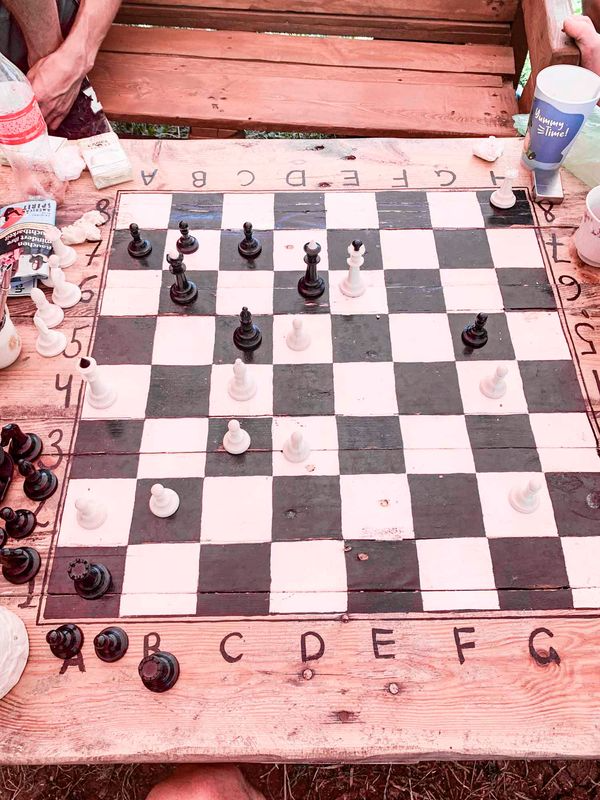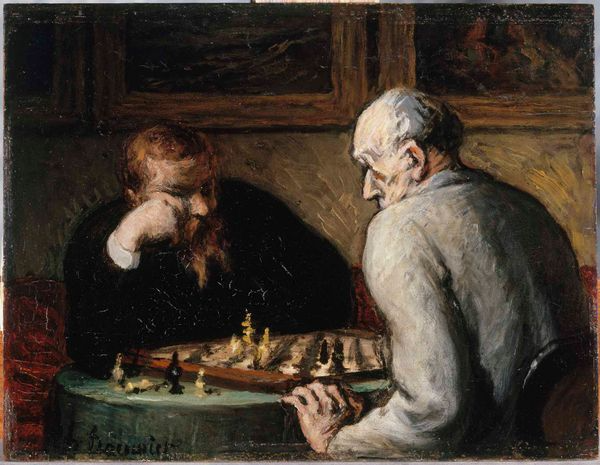The chessboard can be a space for intimacy and development. A musing on the deeper potentials of this ancient game and the nuances of its present popularity in the digital sphere, inspired by an encounter with the game in the country of Georgia.
The morning after an overnight flight to the Youth Section conference in Georgia, I found myself connecting with members of the local Youth Society Parzival over a game of chess. The board was set up under a large canopy strung off the back of the schoolhouse. A large group was content to hide from the sun, chatting, drinking coffee, and watching a game slowly unfold. With the exception of a few smartphones, I realized that a similar scene may have been enacted for hundreds of years: connection across cultures over the simple game of chess.
Georgian culture is connected to many centuries-old traditions. They practice a form of wine-making that predates those commonly used in other places today, and choir singing is a treasured art form and community practice. Enthusiasm for chess, which developed into its modern form in the 6th century, could be included here. After a new Georgian friend told me that he was the chess teacher at his Waldorf school, I found out that the country had made chess a mandatory subject for first-grade students in 2022.

An Old Game and a New World
I am in awe at how this game has traversed so much space and time, and transcends so many cultural boundaries. Rather than being dampened or deteriorated by technological acceleration, chess seems to have thrived in the digital era. Almost as a countercurrent to the dizzying array of games available today, the simple, archetypal elegance of chess seems to have found a strong resonance in our contemporary world.
In the last three years, chess’ popularity has surged. While some of this may be attributable to the Covid lockdowns, according to Google Trends, it was actually in October 2020, well after the first series of lockdowns, that chess took off in popularity, alongside the release of the Netflix show The Queen’s Gambit. The game’s popularity has continued to rise since then, with Google Trends showing peaks in interest in January and August of this year.1 The most popular chess website, chess.com, had more than 57 million active users this past May, a 550% increase since January 2020, making it the 114th most-visited site on the internet.2
In a way, chess is connected to humanity’s mysterious wrestle with technology in our time. In 1997, a supercomputer named Deep Blue, purpose-built to play chess by IBM, beat the then-world champion, Garry Kasparov, in a six-game series. Rather than putting an end to the age-old field of competitive chess, computers have since become tutors and sparring partners for chess players around the world, at all levels. Chess.com features a sequence of bots for different levels of play, all the way beyond the highest contemporary players. After finishing any game on the website, the computer will walk you through each and every move, showing you mistakes, great moves, and missed opportunities. In this realm, it seems that artificial intelligence has found a proper role as an adversary—on the other side of the chessboard, helping us develop the skills to play well.
The Mysteries of Thinking
In its announcement about chess as a compulsory subject, the Georgian Ministry of Education said, “Chess improves students’ multifaceted skills such as attention, concentration, memory, analysis, logic, decision making, spatial orientation and more.”3 Although I’m not qualified to comment on the effect of competitive games for children, as an adult, I appreciate the emphasis on play and games in training the powers of thought—and I can attest to its efficacy myself. The game can be a mirror, quickly showing when I’m shortsighted or impatient. The only way to win is through concentration and imagination. I’ve found the game weaving in with my practice of meditation, especially the first basic exercise, control of thought. I find my acuity in chess greatly aided when I’m devoted to meditation, and it’s one place where I quickly see the results.
For some, intense concentration through the game can lead to mysterious mental territory. A childhood chess champion revealed in his memoir how the cognitive pressure of games lasting up to eight hours forced him into an uncanny space of consciousness: songs would get stuck in his head and get so “loud” as to be extremely distracting. Finding it impossible to totally avoid music, he discovered that he could let his thinking “ride” music playing in his head, granting extra creativity and inspiration to his thinking in games.4 A friend of mine took a similar path from chess into the mysteries: after becoming a champion as a child, his Rabbi recognized that he was ready to be taught Kaballah.
The Queen’s Gambit explores the complexities of these mental capacities in chess—the protagonist starts taking hallucinogenic drugs at a young age and finds herself visualizing complex variations of chess moves, leading to her success. Her struggle to develop this capacity in a lucid consciousness rather than depending on substances is a central thread in the series. This could have been one reason the series was so popular and struck such a strong chord in the collective: as psychedelics become more popular and vivid imaginations more readily available, many are reckoning with the divide between those states of consciousness and their everyday, sober realities, questioning how they can access those states in a more lucid manner. The present fascination with chess might also relate to a recognition of the value of concentration. With attention spans eroded by digital media, sustained, high-quality attention is not a given. Perhaps today, there’s an extra joy to be found in spaces where one can be fully immersed and concentrated.
Still, playing the game in the digital sphere has shadows. My girlfriend sometimes has to awaken me when I’m checked out playing chess on my phone, distracted from something else that could use my attention. Speaking about this with her, she diagnosed that the phone was particularly tempting: there is impulsivity in picking up the phone to play, and the light of the screen is somehow hypnotizing—and not in a way that always leads to concentrated imagination. Indeed, I recognize that I play my best when I’m not behind a screen but playing against a human in the flesh. A digital game of chess is a flattened version of what happens between two humans over a real-life chessboard.

To Play is Human
I was one of those reminded of the joy of playing chess in the last few years—digital games were a good way to stay in touch with friends in the United States while I was living in Switzerland. But the game became particularly important to me when my 15-year ultimate frisbee career came to a sudden halt after I tore my hamstring while playing in the World Ultimate Club Championships. There was grief around losing a source of joy, liveliness, and connection. Chess quickly filled my need for competitive play, and I savored the notion that chess was what James P. Carse would call an infinite game—something that I could continue to play and improve at for the rest of my life, as opposed to ultimate frisbee, where I reached the limitations of my body.
This infinite nature of chess is part of the elegance of the game. Despite being just 32 pieces on a 64-position board, the number of potential piece combinations is unfathomably large. Despite centuries of scholarship analyzing different structures of the game, most games get into completely novel territory in just 10 or 15 moves. Although the same openings might be played again and again, rote memorization of move sequences can only get you so far, especially because the moves of your opponent will always change your plan. Rudolf Steiner spoke about this principle as a metaphor for how people should approach spiritual science: not as a master plan to be rigidly implemented, but as something to be undertaken responsively in adaptation to what comes to us in everyday life. “It is a very great help indeed to be able to play chess well!” he said.5
And yet, I experience the simple act of being able to play as a gift in itself—one of the greatest joys of being human, especially when shared. Schiller said, “Humans only play when one is in the fullest sense of the term a human being, and one is only fully a human being when playing.”6 In the five days I spent at the conference in Georgia, I discovered chess as an intimate space of encounter across boundaries, an opportunity to share in a human spirit. In between the scheduled sessions, a group of us would huddle around the Society’s chessboard, which would alternate between being one of the most contemplative and one of the most animated spaces at the school. Despite coming from different continents, the chessboard was familiar territory to all. Even without a shared language, one could see the animation of the other’s soul through their faces, decisions, and exclamations. Even after fifteen centuries of play, the dance of the pieces unfolds anew, summoning attention and presence. In moments like these, I experience chess as not just a game but a communion, celebrating kinship in being human.
Photo Alexei Maridashvili
Footnotes
- Google Trends.
- Chess.com among 100 most influential companies 2023.
- Chess will be compulsory in Georgian schools.
- Waitzkin, Josh. The Art of Learning: An Inner Journey to Optimal Performance. Simon and Shuster, 2007.
- Behind the Scenes of External Happenings, GA 178.
- Schiller, Friedrich. On the Aesthetic Education of Man (1795) letter 15, para. 9.









